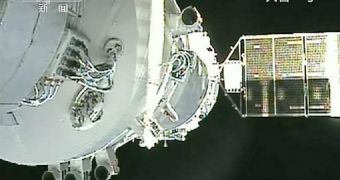Chinese officials say that two unmanned space capsule in low-Earth orbit carried out another successful docking maneuver on Monday, November 14. The spacecraft – which were at first connected – separated and then reunited about half an hour later.
The docking maneuver took place smoothly, say representatives from the China National Space Administration (CNSA). This marks yet another momentous achievement for the country, which is planning to have its own space station ready by 2020.
In order for that to happen, the agency needed to demonstrate that it can achieve automated docking capabilities in orbit. This was an important milestone, made even more significant by the fact that China was the first country ever to attempt robot-guided docking before manned docking.
Russia and the United States – the only two other countries in the world that are capable of such a feat – first conducting such tests using manned spacecraft. The potential for success is higher in this scenario, but then again the risk to astronauts is even more so.
CNSA proved capable of achieving not one, but two successful docking maneuvers using the robotic space capsules Shenzhou 8 and Tiangong-1. The two spacecraft launched on November 1, and September 29, respectively.
“Mastery of know-how is not always solid until proven by repeated experiments,” the state-run news agency Xinhua reports, as quoted by Space. A large number of docking maneuvers are still scheduled to take place over the coming months.
“With a string of sophisticated maneuvers, docking, de-linking and re-docking, as part of its current Shenzhou-8 space mission, China has laid a solid stepping stone for deep space exploration,” the agency adds.
The first link-up between the robotic space capsules occurred on November 2. CNSA celebrated the moment at the time, saying that it had opened a way towards a highly-ambitious space program.
Over the coming years, the space agency will consider how to go about constructing the 60-ton space station it has in mind. Thus far, officials in Beijing have not excluded any type of application for the orbital lab.
In 2012, China plans to launch the Shenzhou 9 and 10 spacecraft, of which one will be manned. The goal is to have orbital docking conducted by a human crew as well, thus augmenting robotic capabilities.

 14 DAY TRIAL //
14 DAY TRIAL //